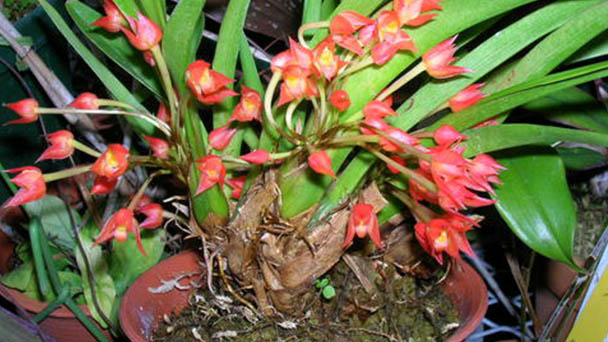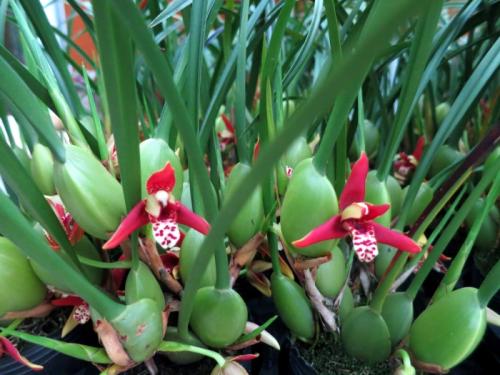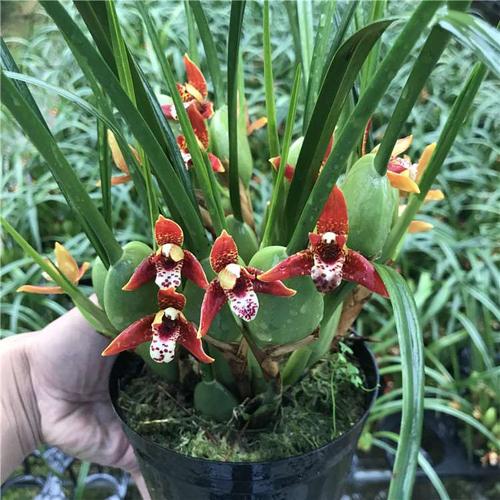Coconut Orchid (Maxillaria Tenuifolia) Profile: Complete Info & Care Guide
Written by Maggie
Dec 07 2021

The Coconut Orchid (Maxillaria tenuifolia), also known as delicate-leafed maxillaria or coconut pie orchid, is a perennial herb of the genus Maxillaria in the orchid family, which has more than 200 species and is mainly distributed in Central and South America. The leaves are linear and the plant has a flat pseudocorm at the base. The pedicels are drawn from the base of the corm. Each pseudocorm produces 2-3 flowers, about 3-5 cm in diameter, bright red to dark red in color.
Coconut Orchid Picture

Characteristics of Coconut Orchid
Coconut Orchid has linear leaves and a flat pseudobulm at the base of the plant. Each pseudobulm produces 2-3 bright red to dark red flowers about 3-5cm in diameter. The flowers are fragrant with cream chocolate flavor.
The flower season is late spring to early summer.
Ecological Habits of Coconut Orchid
Coconut Orchid likes hot, humid weather with plenty of sunshine. In spring, autumn and winter, the sun is mild and full sunshine can be accepted. In summer, the sun moves to a place with half sunshine or avoids the strong direct sunlight at noon.
How to Care for Coconut Orchid
Coconut Orchid Light Requirements
Coconut Orchid requires shiny oblique lighting. You can location your plant on an east- or west-facing windowsill. They will additionally develop nicely in vibrant greenhouses and underneath fluorescent light.
Optimally they need to have around 1500 to 3500 foot-candles of light. However, they can tolerate up to 5000 foot-candles.
If you area your coconut orchid in a low mild environment, the lengthy grass-like foliage will probably extend, as the plant will be looking to capture greater light.
As with most orchids, you need to now not depart it below direct shiny sunlight, which can injury the plant.
Coconut Orchid Temperature Care
Coconut Orchid grows nicely in intermediate temperatures. The most appropriate temperature is around 55F in the course of wintry weather nights and up to 75F for the duration of wintry weather days. During the summertime months, the plant can tolerate numerous tiers warmer.
Although it’s a forgiving plant, do no longer expose it to temperatures outdoor of this varies for an extended quantity of time. Also, make certain there is no bloodless draft always coming from the window immediately to the plant.
Coconut Orchid Humidity Care
Coconut Orchids select a humidity of 50 percent or higher, up to circa 70 percent.
If the room place you are maintaining your orchid is dry, you can use a humidity tray to supply your plant a boost. Alternatively, you can mist the plant each day to expand humidity if the air has humidity under 50%.
Please preserve in thought that if the room is too humid, you require a higher ventilation gadget to preserve the plant healthful and decrease the hazard of diseases.
Coconut Orchid Watering
The watering sample for the Coconut Orchid has to mimic the wet and dry seasons of its herbal habitat.
You ought to permit the medium to dry between watering all through the dry season. Therefore, between December and April, the most beneficial watering is each two to three weeks. However, if you observe that the pseudobulbs are turning wrinkled, this is a signal that your plant is dry, and it is time to water your orchid.
During the wet season, you have to water it around 4 to 5 instances a week. Keep in thought that these flowers get lots of rainfall at some stage in this period, and steady moisture is needed.
You have to nonetheless permit some drying between watering. Be cautious even though no longer to overwater your plant throughout this time, as this can also lead to root rot.
You need to begin to limit the watering frequency steadily around September to put together the plant for the upcoming dry season.
Water pleasant is integral for a Maxillaria. We suggest that you use rainfall, reverse osmosis, or distilled water to decrease the chance of the accumulation of minerals in the root system.
Potting Mix & Pot for Coconut Orchid
If you desire to gain the most herbal seem for your Coconut Orchid, you must think about mounting it on tree ferns or cork. As an epiphytic plant, it grows on tree branches in their herbal habitat; therefore, mounting is an outstanding choice.
You can additionally plant your orchid in pots with fir bark, coir, perlite, and any combine that does no longer enable the roots to continue to be continuously soggy, for example, potting soil. A striking basket with coconut husk at the backside is best for Coconut Orchid. The basket will enable the lengthy grass-like leaves to fall gracefully.
A layer of sphagnum moss and perlite can be beneficial for some water retention, mainly if the plant is in an exceptionally dry environment. Be conscious that the medium has to furnish sufficient drainage. The quantity of sphagnum moss needs to be confined to no greater than 20 percent of the media, to keep away from sogginess.
You can additionally add some horticultural charcoal to your orchid’s potting mix. The charcoal helps to get rid of stagnant water and protects the plant from acidification.
Repotting Coconut Orchid
Like most orchids, Coconut Orchid does now not like root disturbance. If you see that your Coconut Orchid is beginning to stoop a lot over the facet of the pot, it is perhaps time for repotting. Repotting is additionally a proper concept if your orchid appears a bit tired, and a replenished medium would help it.
You have to reflect on consideration on repotting after a spherical of blooming. You can repot the orchid every two years if necessary. Check out our repotting information to study how to do this safely.
When selecting a pot, you need to go for a tighter container as a substitute than a massive one. You do now not choose to have an excessive share of potting media in assessment with the roots, due to the fact a pot large than crucial might also motive the roots to rot.
If your Coconut Orchid has some rotting parts, take away these earlier than intending any further, leaving solely the healthful bulbs. When doing so, for delivered protection, you need to disinfect the scissors and the roots with a plant-specific disinfector earlier than repotting.
Do now not cast off the brown sheaths on the stems between the bulbs of your Maxillaria. Their characteristic is to defend the aerial roots, and doing away with this will injury the roots and, eventually, your plant.
Coconut Orchid Blooms
Coconut Orchids commonly have shiny crimson blooms
Coconut Orchid has a one-of-a-kind deep purple bloom, which grows from one singular flower stem. The lip is white or yellow with crimson spots, reminiscent of a leopard pattern. The recognition is special to every clone, and it repeats the identical sample bloom after bloom.
The aromatic plant life shows up from spring to summer, and they can close for around ten days. The plant life develops in quick stems and seem to be near as if they are hiding below the foliage. The flowers’ candy coconut aroma is extreme and can fill whole rooms with their beautiful fragrance.
When the usage of bloom fertilizers for the duration of the summer season months, some Maxillarias will have an extended blooming time accomplishing till late summer.
Coconut Orchid Fertilizer Care
The satisfactory time to begin the usage of fertilizer in early spring. During this time, you can use nitrogen-rich enricher fertilizer weekly. This kind of fertilizer will assist the average increase and the metabolism of your plant.
During late summer, you can use phosphorus-based fertilizers to stimulate an extended flowering cycle.
You can use quarter-power if the usage of weekly or half-strength fertilizer is used greater sparingly. It is necessary to dilute the fertilizer to forestall root burn for your Coconut Orchid. Watering the plant earlier than and after the use of fertilizer is beneficial. Watering will push the critical elements down to the roots.
How to Propagate Coconut Orchid
The propagation of Coconut Orchid is mainly by dividing plant, and it is more suitable in spring and summer. It can be planted into the pot with 3-5 balls per unit.

Disease Control of Coconut Orchid
Anthrax
This disease is the most common Coconut Orchid disease, mainly damage the leaves, late disease spots on the black spots, the final disease leaves withered and yellow, the disease is mostly in May to June, the plum rain season or September to October autumn rain or typhoon years.
Method of prevention and cure
(1) Cut off the disease in time and burn the sick and disabled body.
(2) Improve the way of watering, that is, from the edge of the pot slowly will be injected with water.
(3) After the germination of new leaves in winter, spray Bordeaux solution (1:1:140)1 -- 2 times, spray 50% carbendazim 500 -- 600 times at the initial stage of disease, and strengthen ventilation and light transmission to avoid foliar spraying.
Leaf blight
Mainly encroaches on the leaves of Coconut Orchid, the initial stage is reddish-brown small spots, and then rapidly expands into elliptical or circular dark brown spots. There are more leaf spots, and the leaf tissues between the spots lose green and become yellow and die.
Method of prevention and cure
(1) Remove diseased leaves and diseased bodies and burn them.
(2) Pay attention to ventilation and light, prevent excessive watering, avoid direct spraying plant.
(3) It can be sprayed with 50% topujin 600-800 times liquid. Every 10 days or so 1 time, even spray 3-4 times.
Southern blight
One of the major diseases of the Coconut Orchid caused by fungi. It is easy to occur in high temperature and rainy season, often in May and June, and in July and August.
Method of prevention and cure
(1) Timely removal of diseased leaves, diseased plants, diseased holes, can be mixed with lime disinfection; Before fixing the plant, wet the basin soil with 30% soil seedling dehydrating agent 1000 times.
(2) At the early stage of the disease, 1:500 times chlorothalonil can be used to spray the leaves and irrigate the roots.
Scale insects
The shield scale and mealybug were the most common. It occurs from April to October, and occasionally occurs in winter. It has strong fertility and can occur in multiple generations and overlapping generations in a year, with the most serious from May to October.
Method of prevention and cure
(1) In a small amount of occurrence, can be used to brush the soft brush, and then rinse with water.
(2) In the incubation period, 1000 times 40% rapid culling emulsion can be sprayed. When the leaf is sprayed, the back should be sprayed, continuous spraying 3-4 times, each interval of 5-7 days, then the basic extinction.
Starscream
Coconut Orchid breeding ability is strong, the harm is very serious, easy to occur in June - August high-temperature period.
Method of prevention and cure
(1) The number of small brush or brush can be used in addition to brush.
(2) Many were killed with 40% dichlorophenol 1000 times solution.
(3) Native method can ignite a plate of mosquito-repellant incense, placed in the pot of the infected plant, and use plastic bags to cover the pot, after 1 hour of smoking, both eggs or adults are killed, and does not affect the plant.
Distribution of Coconut Orchid
Coconut Orchid is mainly distributed in Central and South America.
Garden Use of Coconut Orchid
The main value of Coconut Orchid is to produce fragrance. It can also be used as a potted plant for ornamental purposes.

Latest Updated
- Benefits of Bugleweed - 7 Science-backed Health Benefits
- Bugleweed Dangers & Side Effects - Is It Poisonous?
- How to Plant Evergreen Trees - What You Should Know
- When to Plant Evergreens - Grow Guide for Evergreen Trees
- 12 Wonderful Evergreen Shrubs for Your Garden
- 12 Popular Evergreen Plants with Pictures for Beginners
- When And How To Prune A Lilac Bush Like a Pro
- How to Grow & Care for Lilac Vine (Hardenbergia Violacea)
- Japanese Lilac Tree (Syringa Reticulata) Care & Propagation Guide
- Shumard Oak Pros and Cons - What to Know
Popular Articles
- Winter maintenance of Antirrhinum Majus
- How to Grow Terminalia Mantaly Tree
- How to Grow and Care for Crossostephium Chinense
- How to grow Antirrhinum Majus in spring
- Peristeria Elata (Dove Orchid) Profile: Info & Care Guide
- Underwatered Snake Plant (Sansevieria Trifasciata) - Signs And How To Fix
- How to Care for Brazilian Jasmine Plant (Mandevilla Sanderi)
- How to Grow & Care for Graptopetalum Purple Delight in Summer
- Rosa Chinensis (China Rose): Plant Growing & Care Tips
- How to Care for Baby Sun Rose (Aptenia Cordifolia)